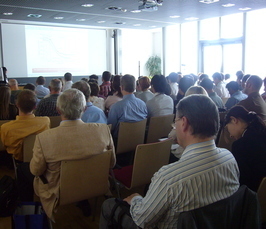MPI Colloquia Series: Prof. Dr. Philip Tinnefeld, DNA in new roles: Tools for Superresolution and Nanobiotechnology
MPI Colloquia Series: Prof. Dr. Philip Tinnefeld, DNA in new roles: Tools for Superresolution and Nanobiotechnology
- Date: Apr 27, 2017
- Time: 04:00 AM - 05:00 AM (Local Time Germany)
- Speaker: Prof. Dr. Philip Tinnefeld
- Institute of Physical and Theoretical Chemistry, TU Braunschweig, NanoBioSciences and Braunschweig Integrated Center of Systems Biology (BRICS) and Laboratory for Emerging Nanometrology (LENA)
- Location: Max Planck Institute Magdeburg
- Room: Big Seminar Room "Prigogine"

The Max Planck Institute Magdeburg invites you to its series of colloquia.
Top-class scientists, invited by the Max Planck Institute Magdeburg, give a survey of their research work. Everybody who is interested, is invited to attend.
DNA in new roles: Tools for Superresolution and Nanobiotechnology
In recent years, DNA nanotechnology has matured to enable robust production of complex nanostructures and hybrid materials. We have combined DNA nanotechnology with sensitive optical detection to create functional single-molecule devices such as nanoscopic rulers for superresolution microscopy and energy transfer switches. DNA origamis are also used for single-molecule placement in zeromode waveguides using nanoadapters and for fluorescence enhancement with gold nanoparticles. I will discuss DNA origami applications to improve single-molecule detection and how DNA origami in combination with the recently developed superresolution technique DNA PAINT can be used to study the interactions of emitters with metallic nanostructures in a single-molecule mirage. Finally, I present a new force spectroscopy that does not require a physical connection to the macroscopic world. Piconewton forces are applied to DNA structures by DNA nanostructures and the influence on the binding of proteins is visualized using Fluorescence Resonance Energy Transfer.